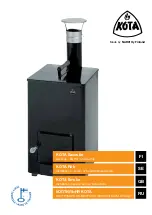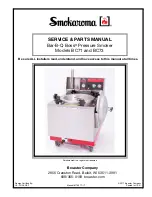
2 3
3. FILTERS
AIR FILTERS
To avoid breakage and damaging the application,
check
and clean the filter at least once a month
. This operation
must be carried out by an authorised technician (the filter is
inside the appliance).
For cleaning: remove the filter from its seat and bang it hard
to clean off the dust. If the filter is dirty with grease, wash it
with degreasing soap, then rinse and dry. At the end of the
operation, refit the filter in its seat.
Every three months it is advisable to replace the filter if it has
deteriorated.
4. IDLE PERIODS
If the equipment is not going to be used for some time, take
the following precautions:
•
Close cocks or main switches ahead of the appliance.
•
Go over all stainless-steel surfaces vigorously with a cloth
moistened with paraffin oil in order to spread a protective
film.
•
Periodically air the room.
•
Have the appliance checked before using it again.
•
To prevent too rapid evaporation of accumulated moisture
with consequent breakage of elements, switch electric
appliances on at minimum heat for at least 45 minutes
before reuse.
5. INTERNAL PARTS
(every 6 months)
IMPORTANT! Operations to be carried out only by
specialised technicians.
•
Check the condition of internal parts.
•
Remove any grime inside the appliance.
•
Check and clean the discharge system.
NB!
In particular ambient conditions (e.g.
intensive
use
of
the appliance, salty environment, etc.) the above cleaning
should be more frequent.
VIII. MAINTENANCE
1.MAINTENANCE
All the components requiring maintenance are accessible
from the front of the appliance, after removing the control
panel and front panel. Disconnect the power supply before
opening the appliance
1.2 MAINTENENCE SCHEDULE
•
It is reccommended the appliance is inspected and
serviced by an authorized person at least every 12
months. For this purpose it is reccommended to draw up
a maintenece contract.
2. FAULTS
Any appliance fault is indicated by the green On light flashing.
The sequence of indications gives the type of fault. A certain
number of short flashes occurs between two longer lighting
phases. The number of short signals represents the fault
code.
Each cooking zone has an internal temperature control
device that is activated before possible overheating,
reducing the cooking zone power by 30%. If overheating
persists, the cooking zone is temporarily turned off.
Cooling is quicker if the pot is taken off the vitroceramic
plate. It is advisable to turn the zone off with the control
knob and wait a short time. When cool, the cooking zone
can be switched on again by turning the control knob
from “0” to the required setting.





























